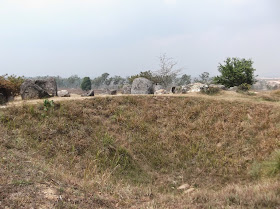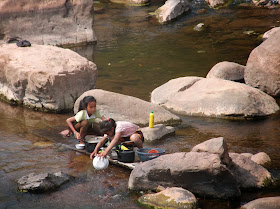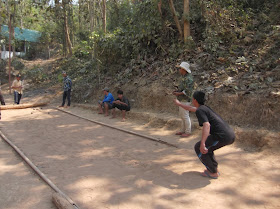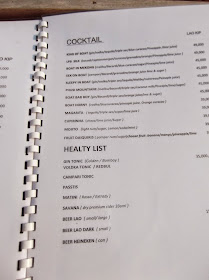An Enigmatic Archaeological Site and an Appalling Indictment of US Policy in SE Asia
27-Feb-2014
 |
| Laos |
Muang Khoun, the Former Royal Capital of Xieng Khuang
After breakfast we set off with N on the twenty minute drive from Phonsavan to Muang Khoun, the former provincial capital of Xieng Khuang, and before that the royal capital of the Kingdom of Xieng Khuang. The drive took us through a rolling landscape of rich agricultural land. Although many fields had been planted with rice, many others were fallow and some contained lines of ponds. These features - and the state of the Muang Khoun - are consequences of the Hidden War.
 |
| Bomb crater 'ponds', Xieng Khaung Province |
From 1964 to February 1973 Laos was bombed by the Americans, at first to support the Royalists in the civil war against the communist Pathet Lao (now the government) and later to disrupt the movement of men and materiel down the Ho Chi Minh trail into South Vietnam. Despite never declaring war, nor officially fighting on the Royalist side, the United States flew 580,944 sorties and dropped 2,093,100 tonnes of high explosive on Laos – an average of one planeload of bombs every eight minutes for eight years making Laos, per capita, the most heavily bombed country in the world. Even these staggering figures conceal a further truth; there was no bombing in Vientiane, where the Lao government was the recipient of huge quantities of American aid, nor in Luang Prabang. The vast bulk of this deluge of death fell on a small corner in the south east and on Xieng Khuang province in the north east. The ponds we saw were bomb craters, the fallow fields were too full of unexploded ordinance to be safely worked.
 |
| Phonsavan is a small town and provincial capital in northern Laos |
I shall return to the UXO (unexploded ordinance) problem later, but for the moment back to Muang Khoun. In the sixteenth century, as the royal capital of Xieng Khuang, the city boasted 62 gilded stupas. Only a couple are left and That Dam, the largest and best preserved, sits, blackened and holed, behind a row of wooden shop-houses at the town’s entrance. It was damaged by invaders and the ravages of time not American bombs. Thai and Vietnamese armies marched across this plain and Chinese bandits pillaged it, stripping the gold from the stupas and digging a hole right through That Dam in the belief it contained treasure. These marauders may have lacked the Americans fire power, but they did not lack their destructive zeal - though most lacked their sanctimonious self-justification.
 |
| That Dam, Muang Khoun |
Muang Khoun just about survived these depredations. After the Kingdom of Xieng Khaung passed it became the provincial capital until it was destroyed by American bombing and the provincial capital was moved to Phonsavan. Muang Khoun is now little more than a village.
 |
| Muang Khoun |
The locals still pay reverence to a Buddha statue that once sat inside a temple. There is little left of the temple, but the statue has been carefully reassembled, as fas as that was possible, leaving it with an enigmatically lop-sided smile. N was keen to tell us the Amerians deliberately targeted the temple, but I am sceptical about that; more likely they did not give a 4X what they hit, and that in a way makes it worse.
 |
| The remains of Muang Khoun Temple and Buddha statue |
A short distance away we visited the remains of a house built by the French and destroyed by the Americans. N said it was a hospital, other sources describe it as a colonial villa, and the colonial administrators certainly found these cooler hill stations preferable to the steamy plain. It looks more like a villa than a hospital to me, but whatever it was it was comprehensively destroyed.
 |
| Whether it was a French hospital or villa it has been comprehensively destroyed, Muang Khoun |
The Plain of Jars: Jar Site 1
From Muang Khoun we drove back towards to Phonsavan to ‘Jar Site 1’. Large stone jars anything up to two metres tall are found all over Xieng Khaung province, but there are three major agglomerations of which Jar Site 1 is the largest.
 |
| Among the jars, Plain of Jars, Site 1 |
Hundreds, possibly thousands, of jars sit on undulating grassland. Who put them here and what for remains a mystery, but it was a time consuming task and obviously important to someone. Best current guess is that they were placed here some two thousand years ago. Local legend has it that a race of giants stored their whiskey in them - there are many jars which explains why no-one remembers the party. Archaeologists, prosaic as ever, suggest they were used in funerary practices - the largest jars would easily accommodate a full grown man in foetal position, but exactly how they were used is anybody's guess. Any information held in the archives of the kingdom of Xieng Khuang went up in smoke along with rest of Muang Khoun in the 1970s.
 |
| Lynne with one of the larger jars, Plain of Jars, Site 1 |
N showed us a cave used as a shelter during bombing raids. A direct hit, he told us, led to the deaths of some 200 people and it is now a shrine. It may have been used as a bomb shelter, but the holes in the roof N pointed out are, according to other sources, natural and ancient. It may once have been used as a crematorium, and the human remains found outside were of people not important enough to qualify for a jar. Like everything else about the Plain of Jars, this is conjecture.
 |
| The cave which may have been a crematorium, Plain of Jars |
N sat in the shade while we wandered about the site. He had not been the most active of guides and his information seemed as unreliable as his work ethic.
 |
| A jar with a lid. Did they once all have lids? Nobody knows. Plain of Jars, Site 1 |
I do not, though, doubt the intensity of the bombing, which is corroborated by many sources. It was also obvious. Jars lay on their sides, many smashed or damaged and although some of this may have happened over the centuries, there was no doubting the grassed over bomb craters liberally scattered amongst them.
 |
| Bomb crater on the Plain of Jars |
There were also many small concrete markers. MAG (Mines Advisory Group - web site here) are a British based charity who, as part of the International Campaign to Ban Landmines, were co-recipients of the 1997 Nobel Peace Prize. They are currently taking the lead in clearing mines and unexploded ordnance in thirteen countries, including Laos. Each plaque represents an item of unexploded ordnance removed by MAG - the whole jar site has been meticulously swept as foreign tourists will, the authorities hope, bring in money, so not blowing us up is a priority. We were, though, advised not to wander into the long grass, nor to pick up or kick at any unidentified object or piece of metal lying around. We took the warning seriously.
 |
| Mines Advisory Group marker, Plain of Jars |
We walked all over the site, spending an hour or more, but the only other visitor we saw was a middle-aged Frenchwomen talking to N. She had come from Vientiane and wanted to go to Luang Prabang and N was arranging to take her next day after dropping us at the airport for our flight to Vientiane. She seemed a brave lady travelling on her own, but we were sure she would be safe with N and his driver, so it seemed a good idea.
 |
| The jars stretch of into the distance, Plain of Jars, Site 1 |
Back to Phonsavan for the Afternoon
Back in Phonsavan we dropped in on the Tourist Information Office. They were closed, but we had only come to see their collection of shells and bomblets, just a tiny fraction of the UXOs that had been collected locally and made safe.
 |
| Shells outside the Tourist Information Centre, Phonsavan |
We lunched in a Phonsavan noodle shop, basic Lao fare but tasty and wholesome.
 |
| Lunch in Phonsavan, I have no idea why am I looking so sour - we had not opened N's envelope yet |
N's Informative if Accidental Missive
After an active morning, at least by his standards, N had the afternoon off, but first he handed over the travel agent's assessment sheet. He had been the least impressive of our guides on this trip and we intended to write a mildly uncomplimentary report, but on opening the envelope we found he had given us the wrong piece of paper. What we had was an email from Laos Airlines to the travel company informing them that our plane to Vientiane the next day had been rescheduled from 11.00 to 15.00. Our wondering about when he intended to tell us turned into the unworthy thought that perhaps he meant to drop us at the airport at 10.00 and head off to Luang Prabang with his new fare, leaving us to discover the rescheduling for ourselves.
 |
| Phonsavan |
Deciding to leave tomorrow’s problem to tomorrow, we took a walk through Phonsavan. If Luang Prabang was the epitome of cutesy charm, Phonsavan was an exemplar of the plain and workaday. There is a building boom, but that did not deter a donkey from wandering down the main street searching for something to nibble. We passed shops selling tyres, car parts, clothes, shoes, religious objects and football shirts - the tentacles of the Premier League (and Barça) reach even to this backwater.
 |
| Football shirts on sale, Phonsavan |
That evening in the hotel restaurant, after a nourishing glass of pastis I cracked and ordered a European meal, the pork steak and chips Lynne had so much enjoyed yesterday. I was disappointed with myself, I do try to eat local all the time, but I enjoyed it.
28-Feb-2014
MAG - The Mines Action Group
N arrived in the morning aware that he had given us the wrong document. His plan was leave to us at the hotel for the morning and send someone to pick us up for the flight. Meanwhile, we suspected, he would be taking his unofficial fare paying passenger back to Luang Prabang. This was not acceptable; without transport we would have been stuck in the hotel, so we demanded he show us more of Xieng Khaung province. The countryside, dotted with villages of the Hmong and other ethnic minorities, would, we felt, be worth exploring.
Reluctantly he agreed and after a delay while he phoned the airport in the vain hope that the situation might have changed, we set off. We drove around for a while but N failed to find anything interesting, maybe he did not want to, or maybe he did not know the area well enough but an hour later we were back in Phonsavan.
We took charge and directed the driver to the MAG Visitor Centre which we had spotted earlier.
 |
| MAG Visitor Centre, Phonsavan |
While looking around their exhibition we were asked if we had seen the film Bomb Harvest. We had not, so we sat alone in their thirty seat cinema and watched the 2007 documentary by Australian film maker Kim Mordaunt.
It is a powerful piece describing why local people are living with danger and how it affects them. It also shows MAG training up its local bomb disposal teams, including several all-women teams, and those teams in operation.
Unexploded ordnance is a problem after all wars. A hundred years after the First World War the so-called ‘iron harvest’ continues and both the French and Belgian armies maintain facilities for dealing with it. Casualties are now rare, but last March two Belgian construction workers were killed by a WW1 bomb.
With 22,000 casualties since hostilities ended, the problem in Laos is far greater, partly because the war is more recent and the country less developed but mainly because of the wholesale use of cluster bombs, a technology unavailable in 1914-18.
Bomb casings, like some of those stacked outside the Tourist Information Office, are designed to open as they fall scattering small bomblets into the ground. 270 million such bomblets were dropped on Laos of which around 80 million failed to detonate and remain live to this day. Locally called bombies (pronounced bom-bees), they are painted yellow and slightly smaller than a tennis ball, the sort of thing a child would pick up and play with - to deadly effect.
 |
| Cluster bomb casings, Tourist Information Office, Phonsavan |
They lurk on the ground and in the wet season they work their way down into the soil, and the next wet season they may work their way further down or back up unpredictably. Bombie education is an important topic in all schools, children know what to do and who to tell when they find one, but still 40% of the casualties over the last decade have been children. Farmers live in poverty because their fields are too dangerous to plough, and even in those that have been returned to use, a plough share can one day hit a bombie that it has missed every year for the past decade or more.
The MAG teams are clearing ten thousand bombies a year – at this rate Laos will be free of the things in 8,000 years. The work is funded by the government of Laos, some international governmental aid and charitable donations. Only very recently has the United States made any contribution, and even then it is pitifully small.
We left the film impressed by the work of the clearance teams, marvelling at the stoical acceptance of the local people, and angry about the earlier actions and present inactions of the United States. You do not have to spend long in Southeast Asia to realise that American policy in the sixties and seventies was disastrous. Their interventions in support of corrupt regimes prolonged civil wars and ratcheted up the death count without affecting the eventual outcomes. But I doubt that even the fiercest hawks intend to be killing people forty years after hostilities had ceased, nor did they intend to blow apart children whose parents were not even born when the fighting stopped. If I am right, they should accept their responsibility and make a serious contribution to clearing up their deadly mess.
Cluster bombs are an indiscriminate and vindictive weapon and in any sane world they would be banned. It took until 2008 to produce the Convention on Cluster Munitions that does just that. It has been signed by 89 countries, including all members of the European Union but excluding the US, Russia and China. Wikipedia quotes Stephen Mull, in 2008 the Acting Assistant Secretary of State for Political-Military Affairs, as saying "Cluster munitions are available for use by every combat aircraft in the U.S. inventory, they are integral to every Army or Marine maneuver element and in some cases constitute up to 50 percent of tactical indirect fire support. U.S. forces simply cannot fight by design or by doctrine without holding out at least the possibility of using cluster munitions." To which I say, ‘Shame on you Stephen Mull; shame on you USA.’
Back upstairs we bought some MAG tee shirts, made a donation and staggered out into the sunshine still feeling angry and upset. To restore some normality we told N to ask the driver to take us to the town market.
[Update: In 2019 MAG marked 25 years of working Laos. By Late 2020 they had cleared over 250,000 mines and unexploded bombs and freed 70 million square metres of land to be returned to agriculture.]
Phonsavan Market
It was a typical market selling agricultural tools - unlike the gardening department at B & Q you are expected to provide your own handle - ....
 |
| Tools, Phonsavan market |
…and a wide selection of fruit and vegetables, some we recognized and some we did not.
 |
| Fruit and veg, Phonsavan market |
And at the end were a couple of local specialities, squirrel and swallows.
 |
| Swallows (on the left) and squirrels, Phonsavan market |
After that it was time for lunch where, sadly, neither squirrel nor swallow appeared on the menu.
Departing from Xien Khoun Airport
It was finally time to go to the airport and let N get on his way. A kilometre of two outside Phonsavan, Xieng Khoun airport is a contender for the World’s Smallest Commercial Airport. We mistook the hut below for the entrance, but actually that is all there is - and with one flight a day to and from Vientiane it is probably enough. Small it might be, but it is a powerful job creation scheme requiring two people to check us in, a third to pick up our cases, place them on the scales and then move them to the X-Ray machine. Someone else moved them off the machine and onto a trolley and yet another person drove the trolley out to the plane. There was also an official to check everybody’s identity card (or passport in our case) and stamp our boarding cards.
 |
| Xieng Khuon Airport |
All this to put thirty passengers on a small turbo prop plane. Laos Airlines do not have the finest safety record, but our Chinese designed and built MA 60 aircraft took off on time (according to the revised schedule anyway) and landed in Vientiane an uneventful hour later.













































